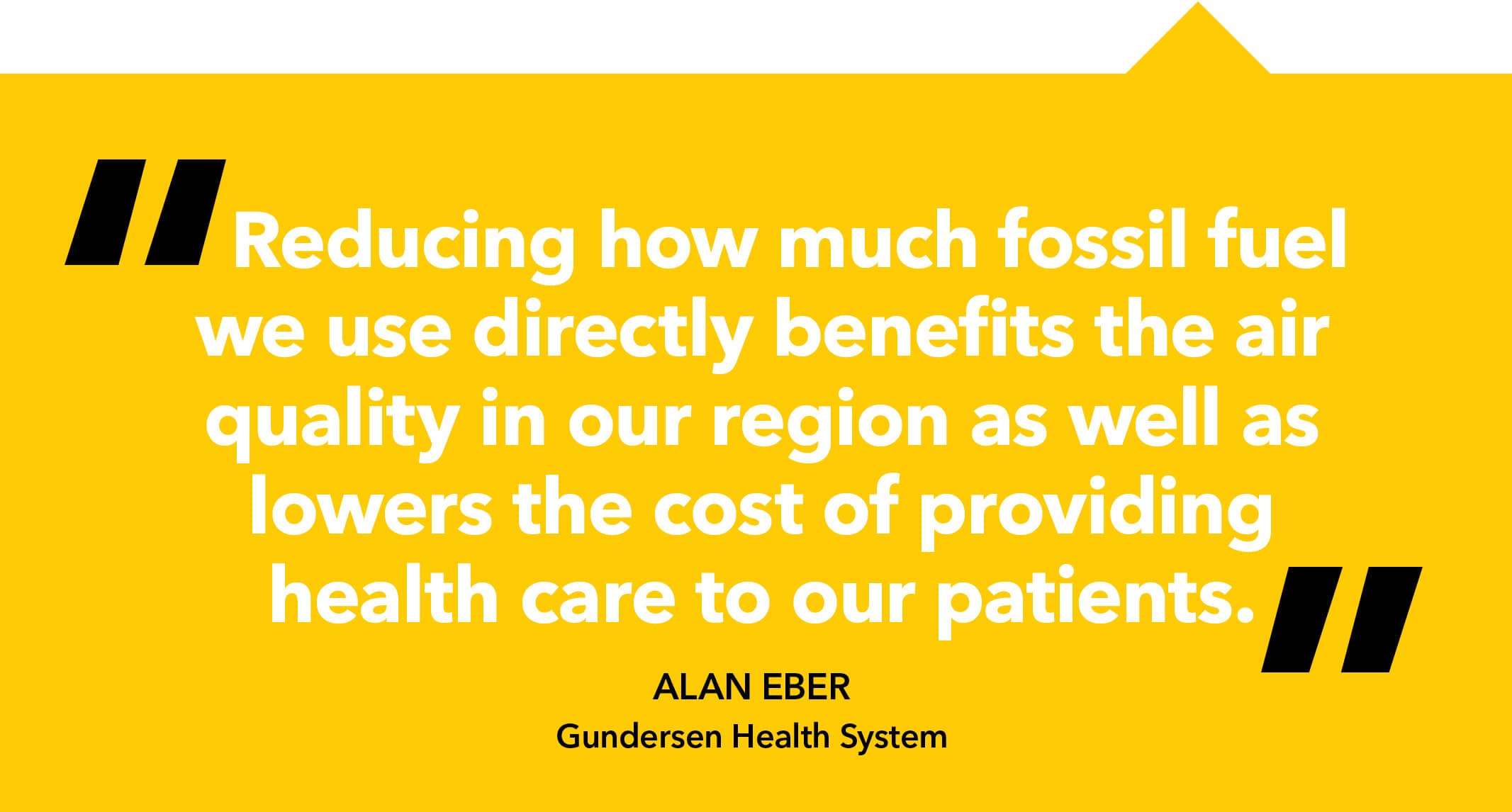5 ways to gain wide support to reduce energy where you work
Using less energy in large buildings may seem like a daunting challenge, but much of the challenge can be eliminated. I know firsthand what’s possible, as Gundersen Health System has adapted to reduce energy usage in our own facilities. In 2014, Gundersen became the first health system in the nation to achieve energy independence.
Little or no support from management is a big obstacle facing many health care organizations that want to reduce energy usage. On my visits to such places, I often see a tendency to sell energy efficiency efforts based on money savings alone. The problem is that the C-suite often weighs options for money when they may not understand the return on investment.

How to Get C-Suite Support
One of the ways Gundersen and others have gained support for energy reduction projects is by linking it to the organizational mission. At Gundersen, it’s straightforward. Our mission is to improve the health and well-being of our communities. Reducing how much fossil fuel we use directly benefits the air quality in our region as well as lowers the cost of providing health care to our patients. Most organizations have missions around reducing waste, improving efficiency, or implementing the values of customers and staff. It’s easy to associate energy reduction with any of those criteria. Once the link to the mission is made, the C-suite will be more inclined to support the efforts.
Once the groundwork for organizational support has been laid, it is easier to get started. The process Gundersen uses is an adaptation from the Six Sigma DMAIC (Define, Measure, Analyze, Implement, Control) process.
1. Baseline the Building(s).
One difference between the DMAIC process and our energy reduction process is this: We measure our buildings before we set goals. It is important to understand how much energy your building is using and compare that to similar buildings. This can be as simple as tracking the energy bills. If the building is very good compared to the benchmarks, it may be difficult or expensive to reduce the energy usage in
the building. On the contrary, if high energy usage against the benchmark is found, one can be more aggressive setting energy reduction goals.
2. Define Goal(s).
The next step is to define smart goals for what you’re trying to achieve. Make sure the goals are specific and can be measured not only when finished, but as the energy reducing efforts are ongoing. This will help to keep the stakeholders engaged. Goals should be aggressive but achievable. At the end, real accomplishment should be made, but don’t let yourself fall short due to unrealistic goals.
The goal should also be relevant, meaning it drives the actions you would like to see. And it should be time-sensitive to drive aggressive action. Nothing will stop engagement like a goal that takes too long to accomplish. Too many issues can arise over time to wane enthusiasm.
3. Identify & Prioritize Opportunities.
Then it’s time to identify and prioritize the opportunities. We have helped many facilities through this process by performing energy audits in their buildings. This is a focused investigation of the building using experienced staff, engineers, contractors, and facilitators to identify wasted energy. We look for areas where excessive energy is being used, used when not needed, or being wasted or used in non-value added ways.
If you work in a large facility, chances are you have plenty of opportunities for energy waste—including computers, projectors, lights, and HVAC systems that are left on even when the space is not occupied. Also, most large buildings have Building Automation Systems where the HVAC controls can be modified to help eliminate waste.
Once you’ve made a list of opportunities, they must be prioritized. The building owner should develop criteria for prioritization. We use total energy saved, project payback, initial capital cost, age of equipment being replaced, improvement in comfort, and reduced maintenance cost.
4. Implement & Measure Progress.
After the energy conservation measures are prioritized, it’s time to implement. This takes planning and coordination, and it can cause significant disruptions to the operations in the building. It is important to measure and share progress early and often. Because of the effort and disruptions, people may lose interest in the goal. Seeing progress helps fuel the fire to achieve the end goal.
5. Celebrate Success.
Finally, once the goal is achieved, it’s important to celebrate. The more you share and celebrate the success, the more your organization will trust you to take on the next challenge.
 Alan Eber is the manager of facility operations, engineering & energy for Gundersen Health System in La Crosse, Wisconsin. Gundersen began testing how much energy a building uses for a given size when it built its 427,000-square-foot Legacy Building with a goal of achieving 115 kBtu per square foot per year, below half of what the average hospital uses.
Alan Eber is the manager of facility operations, engineering & energy for Gundersen Health System in La Crosse, Wisconsin. Gundersen began testing how much energy a building uses for a given size when it built its 427,000-square-foot Legacy Building with a goal of achieving 115 kBtu per square foot per year, below half of what the average hospital uses.

